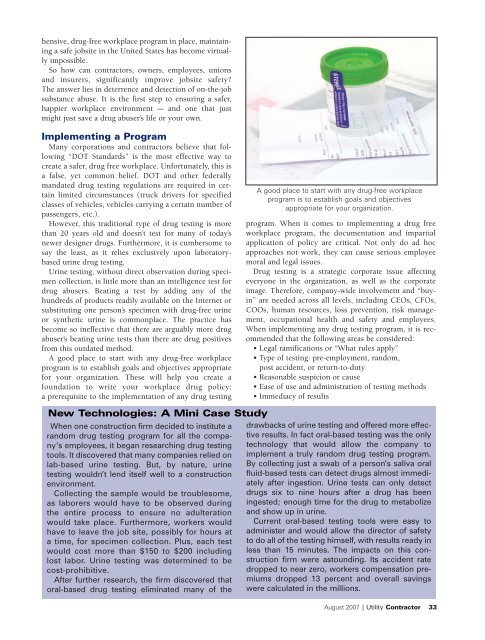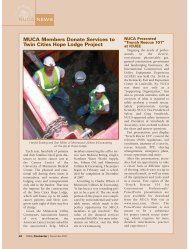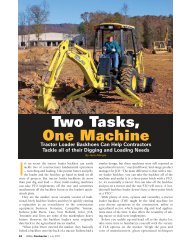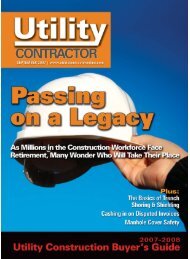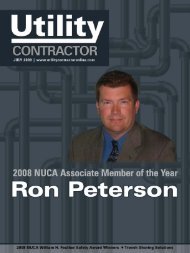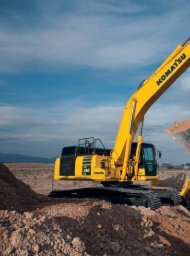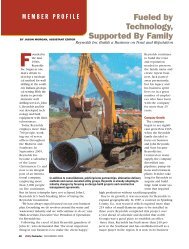View Full August PDF Issue - Utility Contractor Online
View Full August PDF Issue - Utility Contractor Online
View Full August PDF Issue - Utility Contractor Online
- No tags were found...
You also want an ePaper? Increase the reach of your titles
YUMPU automatically turns print PDFs into web optimized ePapers that Google loves.
hensive, drug-free workplace program in place, maintaininga safe jobsite in the United States has become virtuallyimpossible.So how can contractors, owners, employees, unionsand insurers, significantly improve jobsite safety?The answer lies in deterrence and detection of on-the-jobsubstance abuse. It is the first step to ensuring a safer,happier workplace environment — and one that justmight just save a drug abuser’s life or your own.Implementing a ProgramMany corporations and contractors believe that following“DOT Standards” is the most effective way tocreate a safer, drug free workplace. Unfortunately, this isa false, yet common belief. DOT and other federallymandated drug testing regulations are required in certainlimited circumstances (truck drivers for specifiedclasses of vehicles, vehicles carrying a certain number ofpassengers, etc.).However, this traditional type of drug testing is morethan 20 years old and doesn’t test for many of today’snewer designer drugs. Furthermore, it is cumbersome tosay the least, as it relies exclusively upon laboratorybasedurine drug testing.Urine testing, without direct observation during specimencollection, is little more than an intelligence test fordrug abusers. Beating a test by adding any of thehundreds of products readily available on the Internet orsubstituting one person’s specimen with drug-free urineor synthetic urine is commonplace. The practice hasbecome so ineffective that there are arguably more drugabuser’s beating urine tests than there are drug positivesfrom this outdated method.A good place to start with any drug-free workplaceprogram is to establish goals and objectives appropriatefor your organization. These will help you create afoundation to write your workplace drug policy:a prerequisite to the implementation of any drug testingA good place to start with any drug-free workplaceprogram is to establish goals and objectivesappropriate for your organization.program. When it comes to implementing a drug freeworkplace program, the documentation and impartialapplication of policy are critical. Not only do ad hocapproaches not work, they can cause serious employeemoral and legal issues.Drug testing is a strategic corporate issue affectingeveryone in the organization, as well as the corporateimage. Therefore, company-wide involvement and “buyin”are needed across all levels, including CEOs, CFOs,COOs, human resources, loss prevention, risk management,occupational health and safety and employees.When implementing any drug testing program, it is recommendedthat the following areas be considered:• Legal ramifications or “What rules apply”• Type of testing: pre-employment, random,post accident, or return-to-duty• Reasonable suspicion or cause• Ease of use and administration of testing methods• Immediacy of resultsNew Technologies: A Mini Case StudyWhen one construction firm decided to institute arandom drug testing program for all the company’semployees, it began researching drug testingtools. It discovered that many companies relied onlab-based urine testing. But, by nature, urinetesting wouldn’t lend itself well to a constructionenvironment.Collecting the sample would be troublesome,as laborers would have to be observed duringthe entire process to ensure no adulterationwould take place. Furthermore, workers wouldhave to leave the job site, possibly for hours ata time, for specimen collection. Plus, each testwould cost more than $150 to $200 includinglost labor. Urine testing was determined to becost-prohibitive.After further research, the firm discovered thatoral-based drug testing eliminated many of thedrawbacks of urine testing and offered more effectiveresults. In fact oral-based testing was the onlytechnology that would allow the company toimplement a truly random drug testing program.By collecting just a swab of a person’s saliva oralfluid-based tests can detect drugs almost immediatelyafter ingestion. Urine tests can only detectdrugs six to nine hours after a drug has beeningested; enough time for the drug to metabolizeand show up in urine.Current oral-based testing tools were easy toadminister and would allow the director of safetyto do all of the testing himself, with results ready inless than 15 minutes. The impacts on this constructionfirm were astounding. Its accident ratedropped to near zero, workers compensation premiumsdropped 13 percent and overall savingswere calculated in the millions.<strong>August</strong> 2007 | <strong>Utility</strong> <strong>Contractor</strong> 33


